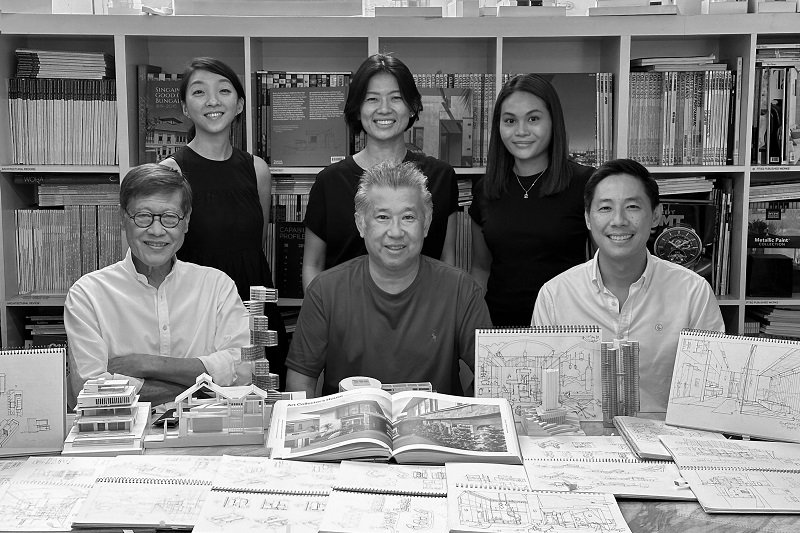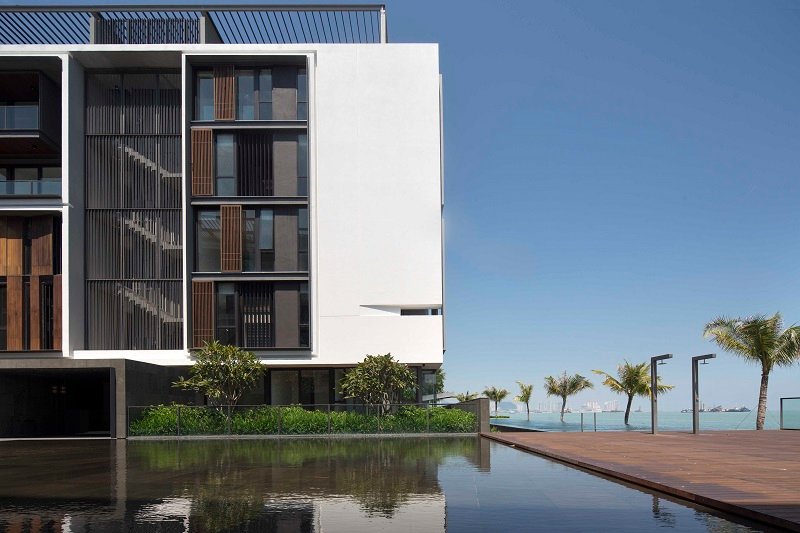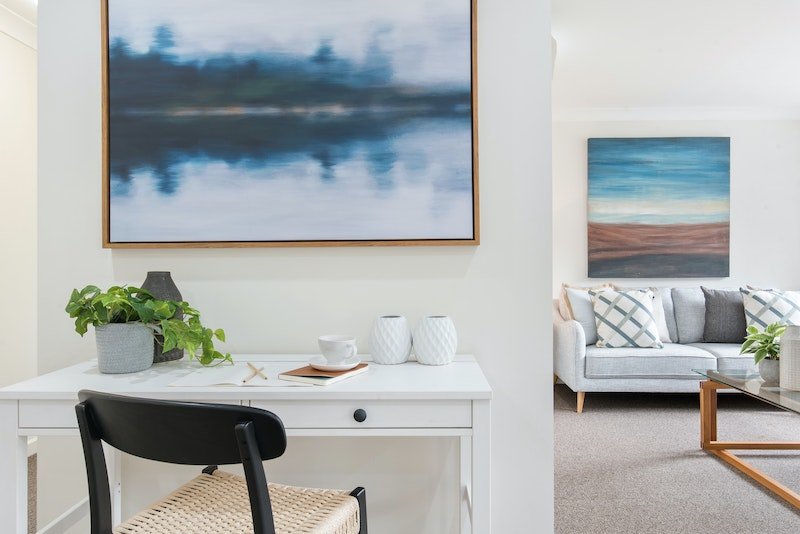With the Singapore Architecture Collection set up, architects Rene Tan and Quek Tse Kwang, founders of RT+Q Architects, reflect on the benefits of a rich archive, and how it has enabled a journey of self-discovery of the firm’s strong design philosophies, opening new possibilities.
2-minute-read
Since it was founded in 2003, RT+Q has conscientiously archived the processes of designing its projects. From having each completed project professionally photographed to carefully storing sketches of early ideas, design development drawings, and even physical models of buildings.

Key RT+Q staffs involved in maintaining the firm’s rich archives, standing from left to right: Liane Ee, Koh Sock Mui, Nazirah bte Adam.
Seated from left to right: Quek Tse Kwang, Rene Tan, Jonathan Quek. Image: RT+Q Architects.
With the firm’s 20th anniversary approaching, they embarked on producing their first ever monograph, reviewing over 170 built projects from their archives to finally make a selection of 29 projects that best illustrates the firm’s journey over the last two decades.
Embarking on a journey of self-discovery
While sieving through the materials amassed from years in the practice, they started to notice recurring themes and ideas. For example, what stood out in many of the firm’s residential projects involved experimenting with building forms to create original, functional designs that adapted modernist architecture concepts for the tropical environment.

Shorefront, a low-rise residential development in Penang, Malaysia, 2016. Image: Albert Lim, RT+Q Architects.
“The detailed records of our projects enabled us to observe a pattern of what worked well, which then formed the foundations of our firm’s design philosophies. It reinforces what we stand for and what we can continue to build upon for the future. We realise through the years that while ideas evolve, instincts don’t,” says Rene.
Keeping options open
Besides rediscovering the RT+Q’s residential projects, the team also unearthed many of their past unbuilt proposals.
“I have an album of unbuilt works on my phone that contains a lot of alternative ideas we have forgotten about. It’s like rummaging through a singer’s albums or a composer’s manuscripts and realising there are many unknown things that are more interesting,” shares Rene.

Rene Tan showing some of his personal sketches which he has kept over the years.
Out of the several design options the firm develops for every project, only one is selected by the client to be built. While drawings of alternative ideas are filed away, Rene believes that they are equally valuable.

Hand drawn sketch of a house at Holland. Image: RT+Q Architects.
“We are often more focused on the finished product. But we forget about learning from the process, where new inspiration for future designs could spark new ideas or enable us to reflect on what worked and what didn’t. This is the true value of a well-kept archive!” he adds.

The many models that RT+Q Architects has produced over the years. Image: RT+Q Architects.
Embracing technology for new options
A look through RT+Q’s archives almost feels like a blast from the past, showing how the practice of architecture has changed over the last two decades. The firm’s early projects were often designed with freehand sketches of spaces as this was how Rene shared his thoughts and ideas with his team.
This analogue way of working gave way to the use of more digital tools across the industry in the mid-2000s. While Rene still enjoys the manual drawing process, which he likens to an exploratory process, digital technologies on balance have made RT+Q more productive and opened up new possibilities. For instance, digital building models created for 3D-printing can be easily converted into virtual reality experiences for clients and visitors too.
“It may be very difficult for everyone to come to the office to see something we’ve built. Ideally, we could have digital models with a QR code for anyone to see it,” says Rene. “Such digital models can be part of our archives too. The exciting thing about digital models is that these can help us further appreciate the more intricate design details of a building that you may not be able to see and experience even in an actual building.”
Contributing to a greater cause
Rene hopes that the collection can help people appreciate more deeply the philosophies, values and thinking of the architectural practice in Singapore and allow more to understand their contributions in shaping Singapore’s distinctive skyline and the places that we live, work, and play in.

House of terracing courtyard. Image: Masano Kawana, RT+Q Architects.
RT+Q’s monograph, “Rethinking the Tropical House: 20 Years of RT+Q Architects” features 29 of the firm’s projects and how its counter-intuitive design approach of “putting the right thing in the wrong place” has made it one of Singapore’s most innovative residential designers.
The firm is contributing some of the materials unearthed for the book and other items from their archives to the Singapore Architecture Collection.
About the Singapore Architecture Collection
The Singapore Architecture Collection reflects deeper efforts to document and preserve archival materials about Singapore’s modern and contemporary architecture. These records not only tell the stories behind the design of our landmarks and everyday places, they can also inspire present and future generations in shaping Singapore’s built environment. Architects, planners, urban designers and other members of the built environment industry are invited to contribute their materials to help enhance and enrich the collection.
For more information about the collection, go to https://go.gov.sg/sgarchitecturecollection. For queries or to donate to the collection, write to enquiry@nlb.gov.sg.
Source: https://www.ura.gov.sg/Corporate/Resources/Ideas-and-Trends/Unearthing-old-records-opens-new-possibilities



